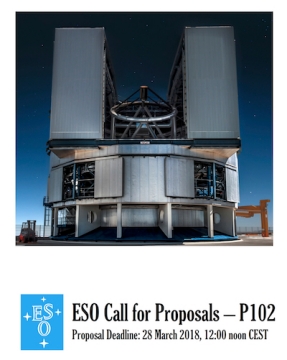The Call for Proposals for observations at ESO telescopes in Period 102 (1 October 2018 – 31 March 2019) has been released. Please consult the Period 102 document for the main news items and policies related to applying for time on ESO telescopes. All technical information about the offered instruments and facilities is contained on ESO webpages that are linked from the Call. The proposal submission deadline is 12:00 CEST 28 March 2018.
Call for Proposals for Period 102
Published: 01 Mar 2018

Important changes for Period 102:
- Teams asking for observations that envision the need for additions to or changes of their list of targets, or that may need to adapt their observing strategy after the start of the Period (e.g., following Gaia DR2 or TESS target releases), must declare it with a note in the "Special Remarks" section of the proposal. The note must include the timescale and the expected cadence of the target change requests. See Sect. 1.1 of the Call for further details.
- ESO encourages Normal Programmes with larger time requests in order to make use of the full range of time available to these types of programmes; i.e., up to 99 hours. The median requested time per VLT proposal has steadily decreased and is now ~14 hours. Starting from Period 102, ESO will actively work to ensure that the distribution of the allocated and scheduled time will be the same as the distribution of the requested time; effectively guaranteeing that proposals of different lengths have an equal chance of success.
- New Large and Monitoring Programmes are not offered on UT4 in Period 102 due to existing commitments.
- Starting from Period 102, Target of Opportunity (ToO) runs will be allowed as part of Large Programmes, i.e., Target of Opportunity observations can be requested over multiple semesters when justified. However, please note that Large Programme proposals with ToO runs cannot make use of the Rapid Response Mode.
- Large Programmes are especially invited for HARPS and the NTT, particularly in bright time for the NTT.
- Note that Large Programmes will only be offered once per year starting from Period 104.
- AMBER is not offered in Period 102 as it will be decommissioned at the end of Period 101.
- HAWK-I observations are offered for the first time using the adaptive optics module GRAAL in tip-tilt star-free mode (see the HAWK-I News page).
- ESPRESSO observations are offered for the first time in 1-UT mode. Two observing modes are available: the high-resolution mode, providing a spectral resolution of 140 000 with a 1" on-sky diameter of the fibre aperture; and the ultra-high resolution mode, providing a spectral resolution of 200 000, with a 0.5" on-sky fibre aperture diameter.
